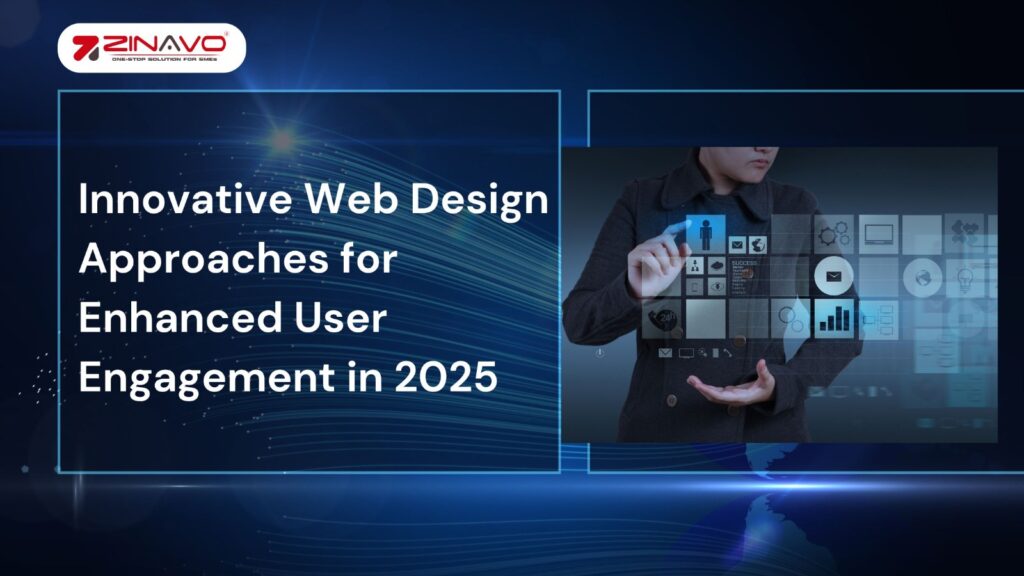Innovative Web Design Approaches for Enhanced User Engagement in 2025
Introduction:
Web design is a detailed process that focuses on creating a well-structured, visually appealing, and user-friendly website. The user experience and design of the website can have a significant impact on user satisfaction within a few seconds. It does not matter how advanced the backend code is, if the user interface is not user-friendly, they will leave. Effective web design balances style with functionality, providing smooth navigation, fast loading times, and mobile responsiveness. Modern trends like AI-driven personalization, interactive elements, and accessibility features further improve user engagement. Let’s explore the key principles of effective web design that drive success in the digital landscape.
AI in Web Design for Personalization
Personalized user experiences are enabled by AI in web design. By analyzing user behavior, preferences, and interactions, these technologies create content, layouts, and recommendations. AI-driven chatbots and virtual assistants offer real-time support, improving user satisfaction. AI helps businesses create user-friendly, data-driven websites that are specific to individual users to make interactions more meaningful and enjoyable and increase overall performance and customer retention.
Simple Web Design: Improving Clarity and Functionality
Simple web design will remain a powerful tool for increasing user engagement in 2025. Clean layouts, simple navigation, and limited distractions help users focus on content without feeling confused. It is important to prioritize functionality so that users can enjoy fast loading times, mobile responsiveness, and accessibility. By using whitespace effectively and adopting a user-friendly interface, websites can improve readability and interaction. Simple but elegant designs create a smooth browsing experience and increase conversions. Businesses that use straightforward web design principles will improve clarity while maintaining a modern style. This will ensure a more enjoyable and efficient user journey in an increasingly digital world.
Here are some tips to remember for designing a clean and simple website.
- Keep the home page of your website simple and do not overload it with too much information.
- Don’t forget to include white spaces in your design. Be sure to leave enough space between sections, paragraphs, and boxes.
- You should limit the number of pull-out menus (dropdowns, fold-outs, etc.) and avoid using sidebars, sliders, accordions, tabs, and carousels.
Mobile-First and Responsive Design:
Mobile-first websites prioritize usability and performance on smaller screens. As most users access websites via smartphones, this strategy improves engagement and accessibility. Responsive design complements this by dynamically adjusting layouts, images, and content based on the user’s device. Whether on a phone, tablet, or desktop, a responsive website delivers a smooth experience. This adaptability improves loading speeds, boosts SEO rankings, and provides greater user satisfaction.
Faster Load Times: Speed Optimization Techniques for Engagement
Fast-loading websites are necessary for user engagement and satisfaction. Studies show that most users leave within five seconds if a page doesn’t load quickly. Large images and videos significantly impact speed, so compress them before uploading. Minimize CSS and JavaScript by eliminating unnecessary code and utilizing asynchronous loading. Optimize server response time by choosing a reliable hosting provider. By improving speed, you improve the user experience, reduce bounce rates, and boost conversions effectively.
Simple Navigation for a Smooth and Easy Browsing Experience
A well-structured and simple navigation system helps users easily find what they need on any website. A simple navigation system also makes it easier for people of all ages and abilities to explore a website. By prioritizing simplicity, websites create a better browsing experience, encouraging visitors to stay longer and interact more with the content.
Below are some tips to make easy-to-navigate applications…
- Make your app easy to use by using the “three-click rule”.
- Users should be redirected to your website’s homepage when they click on your brand logo.
- Add important menus to your footer, such as your terms of use/FAQ/contact/blog, a shortened menu, or social icons.
The Role of Colour Palettes in Branding and Visual Appeal
Colour palettes play a crucial role in branding by shaping consumer perception and emotional connection. Different colours trigger specific feelings:
- Blue conveys trust,
- Red sparks excitement,
- Green symbolizes growth.
A well-chosen palette makes a brand easily recognizable and memorable. The right color scheme also influences purchasing decisions, guiding customers toward a brand’s desired image.
SEO-Friendly Web Design: Balancing Aesthetics with Performance
A well-designed website should not only be visually attractive, but also optimized for search engines. Striking the right balance between appearance and performance delivers an engaging user experience while improving rankings. Fast-loading pages, mobile responsiveness, and clean code improve SEO without compromising design. The usability of your website can also be improved by maintaining a proper content hierarchy and reducing unnecessary scripts. By using SEO best practices with attractive visuals, businesses can create a website that not only looks great but also ranks well in search results.
Conclusion: The Future of Web Design and User Engagement
The future of web design is centered on innovation, accessibility, and user engagement. Businesses must adapt to meet evolving user expectations as AI-driven personalization, immersive experiences, and minimalist design continue to shape digital landscapes. Faster load times, responsive designs, and easy navigation will remain important for engaging visitors and improving interactions. As digital experiences become more efficient and environmentally responsible, sustainable and ethical design practices will gain popularity. By using these advancements, web designers can create attractive, user-centric websites that drive engagement, improve brand identity, and secure long-term success in an ever-evolving digital world.



